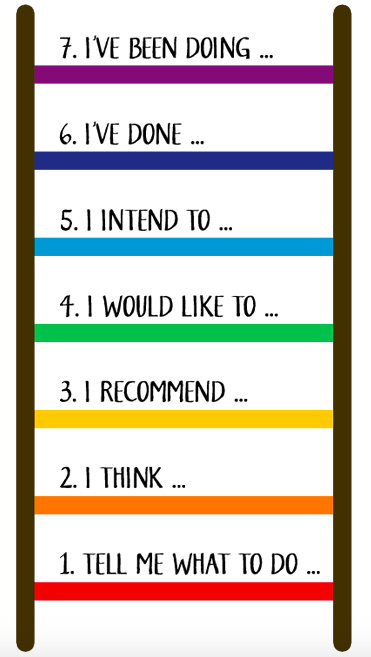Sometimes our people aren’t taking initiative in the way we hope they will. This could be due to an issue of motivation or a lack of safety or more generally a system that discourages that initiative in some way. Whatever the reason might be, we need a way to change the conditions to get the result we want.

One model that can help with this is David Marquet’s Ladder of Leadership, which focuses on actions that the leaders can take, to make it safer for the workers to do their best work.
Understanding the model
1. Tell me what to do
At the lowest level, the people aren’t ready to take any initiative themselves. Perhaps they’re unmotivated or perhaps they perceive it as being unsafe for them to take any initiative. At this level, we need to just tell them what to to.
2. I think
We’d like to get them out of level 1 as soon as possible so we start by asking them what they might think. We’re still holding responsibility for the decisions themselves and are still telling people what they should do, but we’re asking for them to think through the problem and to share their thinking. There is no accountability at this stage, merely thinking. “What could we do?”
3. I recommend
Once they’re sharing what they think, we’ll like to step up to the level of recommendation. “What do you think we should do?”. Note that there is still no real accountability - the leadership is still making the final decisions, however we are asking them to make a recommendation.
4. I would like to
Now we ask for a stronger version of the third level. We want an opinion that we can discuss. Leadership may still decide to do something different but we’re now at the point where we are beginning to delegate some control.
5. I intend to
At level 5, we are allowing our people to make the decisions while still retaining veto power. Unless we see something problematic with what they intend to do, we should allow them to take those actions.
6. I’ve done
At level 6, we have given control and are not even notified until after the action has taken place. We’re still notified shortly after, so that in the event of a problem, we are able to react fairly quickly.
7. I’ve been doing
At level 7, we’ve completely delegated authority. We still want to be aware of what’s happening but it doesn’t have to be immediate. Our people will notify us if they need help.
Using the model
I’ve been talking so far as if we want to move our people up through the levels, and most of the time that’s exactly what a good leader wants to do. There are exceptions to that for some risky kinds of decisions, however. Sometimes the implications of a bad decision are significant enough that we want to keep more control over them.
David Marquet came up with this leadership model while commanding a nuclear submarine1 and he gives the example of firing weapon systems as being something that he personally wanted to control. Any decision that could result in loss of life would come from him, and only him. Decisions about vacation policy or general operations of the sub, however would be delegated as far as possible.
It’s important to recognize that while our actions can help people move upwards in this model, they can also force people downwards. When someone asks us what to do, if we always give them the answer, they’ll start to expect the answer and will stop thinking for themselves. It takes deliberate effort on our part to change the behaviours we see and to get the results we want.
The more orders we give, the more people will expect orders to be given and the less they’ll do for themselves.
How would you use this model? Start by identifying where your people are now and see if you can move them up one step. Then another, and another. Moving from the bottom to the top in one step is far too overwhelming, so we want to take small steps.
-
Turn the Ship Around tells the story of how he developed this model. ↩
